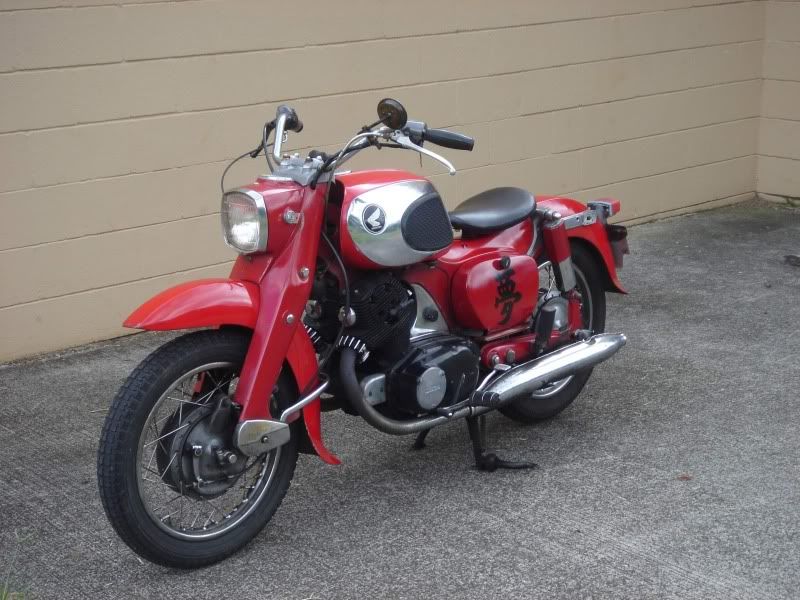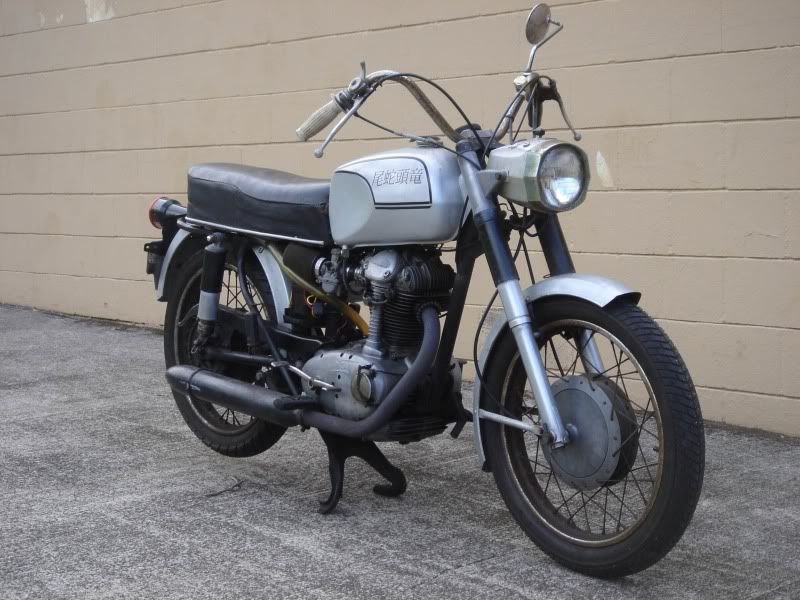どたい、失敗を恐れて何もしないなんて人間は、
最低なのである。
The most contemptible people are those who
never attempt anything because they fear failure.
Sõichirõ Honda
If we are to believe what the Buddhists tell us, that suffering is caused by desire and that true happiness can only be achieved by not wanting - not an easy path to follow in the hyper-materialist world in which we live - what is one to do when one wants a certain motorcycle? The answer is to not want it too badly, and to not give in to the costly temptations of instant gratification. Let the motorcycle find its way to you. This philosophy has served me well over the years, as virtually all the bikes I've wanted have, sooner or later, come to me.
So it was with this 1966 305 Honda Dream, which I found quietly rotting away in the local salvage yard. Modern motorcycle shops, reeking of the consumerist Zeitgeist as they do, have always repelled me. But in the salvage yard, like a doctor in a refugee camp, I feel right at home and the Dream called out to me like a long-lost friend. After some brief haggling and the exchange of $150.00 it was mine. (If only human friendships were so easily managed!)
My neighbor looks on in disbelief as I roll the rotting hulk into the backyard. Rusted, faded, and filthy, 'Nightmare' would be a more fitting moniker. But like Robert Pirsig and his handlebar shims made from aluminum beer can in Zen and the art of Motorcycle Maintenance, I can see beneath the superficial form to the underlying function below.
Two paths to enlightenment

Following the spark-and-gas mantra of the mechanic, I pop off the points cover and go to work. Because the Dream uses a 360° crank (meaning that both pistons rise and fall together) a single coil with dual leads and a single set of points are all that's needed. This means that one spark plug is firing on the exhaust stroke while the other fires on compression. This makes for an extremely simple ignition system. To set the timing you simply slip a piece of cellophane from a CD wrapper between the closed points, put a wrench on the end of the crank, and adjust the points so that the cellophane is released when the timing marks line up. This absurdly simple process takes all of about ten minutes.
Then, off with the carb! Remove the jets and clean them with a single strand of copper wire pulled from an old wiring loom, cleanse the swamp growing in the float bowl and, everything spic and span, put it all back together. This technological tour de force takes about forty-five minutes. Now, before forking out the big bucks for a new battery, borrow a battery from another bike, dump some fuel in the tank (check for fuel flow from the petcock) and tromp on the kickstarter.
Eureka! After 20 years in exile the Dream starts on the first kick! I can't believe it. Smiling at the once familiar engine sounds, and noticing the faint puffs of blue smoke from the left muffler, I am again reminded of what Peter Egan called, “the abiding patience of forgotten motorcycles.”
Like a sixteen-year-old giddy with his first bike, I am excited beyond reason and, heart beating rapidly, can hardly wait to push it out of the yard and go for a ride. Zooming off down the street, exhaust blatting from rusted mufflers, I'm laughing like a fool, my teeth fully exposed for bug catching. The clutch is frozen, but after about a few minutres of riding with the clutch pulled in and the rear brake applied it frees up and works fine.
After a few days of guiltless fun the smoke from the left exhaust shows no signs of abating, telling me that the rings on that cylinder are stuck in their lands. No worries, the bike will have to come apart for a thorough cleaning and repaint, anyway. And pulling the cylinder off these mechanic-friendly old Hondas is hardly more difficult than any of the other tasks.
The restoration proceeds without trouble. Quiet evenings are spent lacing stainless spokes, trips are made to the paint store, a few bits get re-chromed, parts arrive from odd corners of America via the extensive classic-bike network - cheap therapy.
Bolting everything back together, I can almost feel the spirit of old Sõichirõ in every part. This is a bike built by mechanics for mechanics. It's easy to work on, everything fits, there's always space to get a wrench in where needed. And, make no mistake, this is one of the toughest and most reliable engines ever built. Unlike many modern bikes which often run their camshafts directly on the head castings, the cams in these old Hondas run in sturdy ball bearings, making them infinitely rebuildable. Huge crank bearings let you rev the snot out of it for hours on end with no concern for mechanical mayhem. But you must keep the oil clean and change it regularly, because the centrifugal filter on the left end of the crank is not nearly as efficient as a cartridge filter.
As the bike takes on recognizable shape, I find myself thinking back to when the first Dreams hit the streets. We thought they were the most pitiful excuses for motorcycles that we had ever seen - and we wouldn't have been seen dead on one. Only nerds rode Dreams, real men rode Triumphs, BSAs and Harleys. Today, most of those nerds are multi-millionaire tech mavens and the Dream, strangely enough, seems so very cool, and not just to aging boomers reminiscing about their carefree youth.
What is truly remarkable is how cool it seems to young people. Again and again I get approached by twenty-somethings, all of whom invariably say: “Wow, what a cool bike. What is it?” They don't know whether it is old or new, Japanese or American. Free of prejudices, they judge it purely on appearances, which, in today's fashion-obsessed youth culture, mean almost everything.

Saved from the wrecker - the author's 1966 Honda 305 Dream, an example of Sõichirõ Honda's jinja-bukkaku style derived from traditional Japanese architecture. On the side cover is the Japanese character for dream.
In Japan, this design was called the jinja bukkaku style, and it first appeared in 1957 on the 250cc C70. A jinja is a Shintõ shrine and a bukkaku is a Buddhist temple. This was Sõichirõ Honda's bold attempt to create a uniquely Japanese design based on traditional Japanese architecture and marked a radical departure from the largely derivative style of contemporary Japanese motorcycles. Judging from the large number of unsolicited compliments the Dream receives, one could argue that Honda was as far ahead of his time as a stylist as he was as an engine builder.
The Dream's dubious coolness aside, for me the Dream and other old bikes evoke the values we motorcyclists have so thoughtlessly abandoned - the values of motorcycling's paradise lost. These simple machines remind me that we can avoid the materialist trap set by our society and, in so doing, rediscover the essential qualities of motorcycling.
Unlike modern bikes, which intimidate the owner with mechanical complexities too mysterious for the uninitiated to ever unravel, the old bikes and their simple technology welcome your hands, your care. They invite you to take apart that carburetor, check those points, pop open that cover and have a look inside.
It is a care that is well rewarded.
Parking the Dream on the street the other evening, an older fellow walks by with his missus and the dog, comments favorably on the bike and says, wistfully:
“Those were good bikes.”
They still are.
[Postscript: Shortly after completing the restoration I was afflicted by a bout of temporary insanity that drove me to take a job in the center of town. Parking space was at such a premium in this location that even employees had to pay $50 per month to park their cars. Motorcycle parking, however, was free. So for next three years - until my mental affliction abated - I rode the Dream to work every day. For a change of pace I would occasionally ride my UAB (Urban Assault Bike), a Ducati 350 Sebring.

But most days, rain or shine, I rode the Dream. Over those three years the Dream never suffered even a single mechanical malfunction. And at a savings of $600 per year in parking costs, over those three years the Dream completely paid for the entire cost of restoration.
I still ride it semi-regularly to my current part-time job, and it still delivers the same flawless reliability.]


